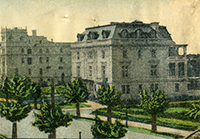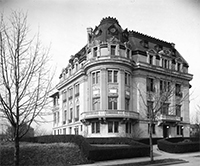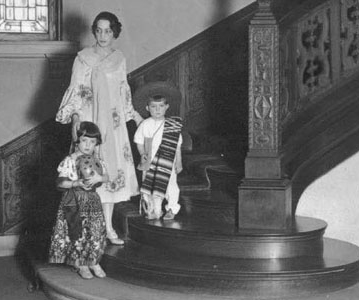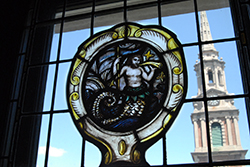History: Nathan Wyeth

MCI HISTORY: NATHAN C. WYETH ON MERIDIEN HILL
BY PAMELA SCOTT, ARCHITECTURAL HISTORIAN

The steep rise of Meridian Hill impeded the development of a neighborhood atop this commanding site just a mile north of the President’s House until early in the twentieth century. In 1888 former Senator John Henderson and his wife Mary Foote Henderson were the pioneers when they built their late Victorian home on six acres just above Boundary Street (Florida Avenue after 1890). Mrs. Henderson’s ambition was to create a diplomatic community along the heights of Sixteenth Street to rival, if not surpass, the neighborhood Kalorama and “Embassy Row” along Massachusetts Avenue. Beginning in 1905 she commissioned architect George Oakley Totten to design eight of the fifteen mansions erected on Meridian Hill. Totten had studied architecture at Columbia University, winning the prestigious McKim Travelling Fellowship to study at the Ecole des Beaux-Arts in Paris for two years.

Because Mary Henderson intended her mansions be rented or purchased as foreign legations, Totten seems to have intentionally designed them in a series of European national styles of architecture. Sometimes their exteriors and interiors proclaimed the artistic heritages of their prospective future residents, most notably the 1905-7 French Embassy built for Ambassador J.J. Jusserand at 2460 Sixteenth Street. Totten’s modern revival of a Louis XIV style mansion revealed him to be an erudite architect with both academic and first-hand knowledge of comparable buildings in France. The aesthetic and pragmatic fitness of a residence to its occupant’s position was integral to the rules taught at the Ecole, as were its spatial organization and the hierarchy of the decoration of its rooms. Within these general parameters two attitudes about the appearance of mansions emerged. Totten was a leading proponent of rich exterior architectural decorations that announced lavish interior embellishments inspired by European seventeenth-century Baroque architecture. The second school of thought was rooted in Italian Renaissance traditions admired by late eighteenth-century French architects: elegantly proportioned, but somewhat severe, exteriors intentionally masked the richness of a mansion’s interiors. Clients chose their architects accordingly, some preferring to display their positions while others chose to protect their privacy in quieter surroundings.
In 1909 when Chicago banker and businessman Franklin MacVeagh was named Secretary of the Treasury in William Howard Taft’s administration, the MacVeaghs rented from a fellow cabinet member Totten’s first house on Meridian Hill, the Venetian Gothic mansion at 2600 Sixteenth Street. They were connoisseurs of fine architecture, having chosen H.H. Richardson, America’s leading architect of the 1880s and 1890s, to design their Chicago home. When Emily MacVeagh determined in 1909 to commission a house as a secret Christmas present for her husband, she selected Nathan C. Wyeth as her architect, probably because she considered him Washington’s best Beaux-Arts architect. She might have known of Wyeth’s heritage and architectural abilities while still residing in Chicago; she would certainly have known he was selected in 1909 to design Taft’s office, the first Oval Office. Wyeth was born in Chicago in 1870, descended from a Welsh family that settled in Cambridge, Massachusetts, in the second quarter of the seventeenth century. His grandfather had crossed the Continent to Oregon in the 1830s before settling in Chicago, his father a banker who contributed to the frontier city’s rise in importance.
Wyeth’s artistic talents were fostered from his youth. He spent 1888 in Belgium and Switzerland studying watercolor painting and the following year enrolled in a Michigan military academy but left to attend the New York Metropolitan Museum of Art School. In 1890 he won its D.L. Mills Prize for “general excellence in architecture.” Wyeth returned to Europe and in 1892 was accepted at the Ecole where he received a diploma in 1899, the only Washington-based architect who had studied at the Parisian art school to complete its rigorous program.

Wyeth probably settled in Washington because his mother and step-father, an Army general, had moved here in 1895 and he was assured of the prominent place in society enjoyed by the families of military leaders. Between December 1899 and 1904, Wyeth worked as an architectural designer in the Office of the Supervising Architect (which designed most of the government’s buildings nation-wide) and as the chief architectural designer in the Office of the Architect of the Capitol. In June 1900 Wyeth was elected a member of the American Institute of Architects, his superior education talents recognized by his colleagues as more valuable qualifications than his meager professional experience. These important positions in large offices were the prelude to his private practice, begun in 1904 but interrupted by the outbreak of World War I in 1917 and curtailed by the Depression of the early 1920s.
Wyeth’s private work was divided between mansions for Washington society and small institutional buildings, especially hospitals. His mansions, designed alone or in partnership with others, drew on two historical prototypes: red brick Colonial Revival houses (their eighteenth-century origins found in late Renaissance architecture transmitted to the colonies via books) and stone or tan brick town houses based on late eighteenth-century French Louis XVI exemplars. In some cases the Colonial Revival houses were commissioned by descendants of early American settlers to commemorate their heritage while many European-inspired mansions were commissioned by self-made men, America’s modern equivalent to European aristocrats. Most of Wyeth’s domestic commissions were on or near Embassy Row in the Kalorama neighborhood; the Franklin and Mary MacVeagh House is his only work on Meridian Hill.
Subdued, elegant, and beautifully proportioned facades were one of Wyeth’s great strengths as an architect. For a tall free-standing townhouse, located on a high commanding site like the MacVeigh House, he controlled its visual height in several ways. The light brown brick walls blend with the stone window frames and four horizontal bands that enwrap it. At the same time these raised courses of stone demarcate the middle two floors as those for entertaining and guests, the height and variety of the second story windows indicate the rooms located there are for the family’s most important functions.

The Beaux-Arts educational system fostered rational architectural solutions based on how each building would be used by occupants and visitors. Once floor plans were perfected to meet the needs of its occupants and visitors, each building’s exterior form and interior decor moved forward. The MacVeagh House was designed for large-scale entertaining by and for cultured peoples and its character was meant to reflect both the interests and pattern of living of its owners. Once Wyeth determined the placement of all of its public and private rooms, movement through them by owners, guests, and servants was settled, as was the kind of light best for each room according to its function. Wyeth repeatedly masterfully achieved the Beaux Arts maxim that “plans generate facades.” The MacVeaghs’ notably active public and private lives required a large house, the symmetry and formality of the front facade on the four-story town house Wyeth designed for them pre-ordained by its classical antecedents, their own tastes, and Wyeth’s sense of propriety. The arched recessed entrance marking the central axis was reinforced by the Palladian window and balcony above it. Although internally this axis is critical to the house’s internal spatial organization, it is neither restrictive nor obvious when moving through the house.
A common device employed by Beaux-Arts architects to increase the sense of internal spaciousness and privacy was gradual ascent from the entrance level to the main rooms. Wyeth’s five shallow exterior steps leading to the door open to the vestibule, its axis unexpectedly perpendicular to the main axis. By introducing an immediate diagonal view through a wide columnar screen of the main staircase to be reached by five more steps, Wyeth subtly invited the MacVeagh’s guests to ascend the wide and inviting staircase, a particularly gracious welcome to their home. While a central front door implied a staircase on its axis, Wyeth chose to place the stair on the hall’s north wall to create a spacious room that creates a seamless division between the welcoming and business functions of the front half of the entrance floor from the service rooms in the back half.

Flowing space filled with light characterizes the MacVeagh House’s principal floor. All rooms except the conservatory at the east end of the house open onto the spacious and elegant upper stair hall. The relative sizes of the rooms indicate the MacVeaghs favored large dinner parties, likely coupled with musical evenings. The relatively small drawing room facing the hall was originally called the “gold room,” indicating the rich color harmonies of its original fabric wall covering. In contrast, the very large dining room with its heavy boxed oak beamed ceiling and wainscoting below plastered walls is a formal room. These heavy and somber architectural elements are immediately counteracted by the tiled and light-filled conservatory, an unusual—almost whimsical—informal addition to such a sober space. The conservatory’s original appearance is not known but it was connected to the butler’s pantry indicating it was used for informal dining.
The MacVeagh House’s music room facing Sixteenth Street spans the house’s entire width, its magnificent original decorations intact. The historical precedent for the painted decorative panels on the lower half of the walls is the Salle de Gardes du Roi at Chateau Fontainebleau, permission to copy them reputedly granted by the French Department of Monuments. In contrast to their heraldic nature the ornamentation on the upper walls is freer, partially because they were painted on burlap rather than canvas, apparently to aide with the room’s acoustics. Wyeth surely designed the gentle curve of the coved ceiling with its shallow arches to enhance further the quality of music in this room. An organ was an unusual musical instrument in a private house, suggesting the MacVeagh’s particularly favored sixteenth-century music of the era when the Chateau of Fontainebleau was built for the French King Francois I. The music room’s elegant semi-elliptical stone and composite chimney piece that rises the full height of the room was inspired by French architectural traditions of the same era. The muted gold, cream, and blue colors of this lovely room bespeak the refined tastes of architect and clients equally.

Although the third floor of the MacVeagh House was ostensibly reserved for family and intimate guests, the three-story stair hall continued its ascent, possibly because MacVeagh met with male guests in his library located above the music room. Frequently America Beaux-Arts houses in a wide variety of historical styles included walnut or oak paneled and beamed libraries in the tradition of English libraries of the seventeenth and eighteenth centuries. Fortunately Wyeth’s design for the MacVeagh survives in excellent original condition. Smaller windows and a profusion of stained glass plaques help limit light destructive to both books and the tapestries covering the walls above the bookcases, reputedly woven by the Gobelins works in France. Deeper shades of gold, creams, and blues carried over from the music and gold rooms on the main floor complement the variety of dark woods—oak on the floor and mahogany for the chimney mantle, book cases, and ceiling beams. As subtle as the nine panels between the beams, painted or stenciled on canvas, are, they complemented the softness and coloration of carpets to finish a remarkably handsome room.
Wyeth designed for the MacVeaghs an elegant jewel box, the richness of its treasures within only hinted at by its understated exterior. Although Wyeth depended on some borrowed historical elements to convey some desired associations for the MacVeaths he designed a unique house that is neither formulaic nor ostentatious. The papers of both architect and clients are lost; in Wyeth’s case probably a victim of European Modernism that supplanted the Beaux-Arts architectural educational system in American schools of architecture beginning in the 1940s. The anti-historicist mantra Modernists preached, coupled with the demise of Wyeth’s architectural office before his death, meant that his drawings, a major part of his architectural legacy, was destroyed. Fortunately Washington’s diplomatic community, in need of the kinds of formal entertaining spaces and spacious living quarters for embassies and chanceries, saved most of the city’s early twentieth-century mansions into an era when their aesthetic qualities are again valued.
NEXT > Mural Artist Roberto Cueva del Río
